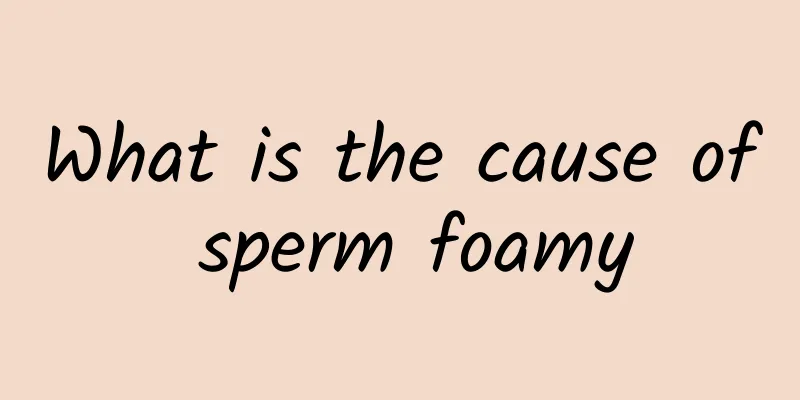What is the cause of sperm foamy

|
Sperm is an important substance for male reproduction. Whether it is abnormal or not directly determines male fertility. Sperm is generally in liquid form, and everyone should be familiar with its shape. However, some men have foam in their sperm after ejaculation. Such an abnormality is definitely very worrying, and they are worried that there is a problem with their sperm. So, what is the matter with sperm foam? Let's take a look at the reasons for sperm foam. It may be caused by prostatitis Causes Only a few patients have an acute history, and most of them present with chronic, recurrent symptoms. The main pathogenic factors of type I and type II prostatitis are pathogenic infection, mainly Escherichia coli, Klebsiella, Proteus and Pseudomonas aeruginosa. Pathogens invade the prostate with urine, causing infection. Pathological anatomy confirms that prostatitis lesions are generally limited to the peripheral zone, where the glandular duct opens in the posterior urethra in the opposite direction of the vertical line of urine flow, which is easy to cause urine reflux, while the glandular ducts in the central zone and transitional zone are consistent with the direction of urine flow, and are not easy to be infected. The prostate has as many as 15 to 30 ducts opening on both sides of the seminal colliculus, and the prostate epithelium has a strong secretory function. The gland is small but the secretory function is strong, and the ducts are narrow, which causes the prostate to be compressed and blocked under the influence of various factors, which can easily cause congestion and secretion accumulation, thus creating conditions for infection. This is also the histological basis for the easy recurrence of prostatitis. Excessive sexual activity, excessive masturbation, long-term sitting, riding a bicycle, riding a horse, alcoholism, excessive spicy food, colds, etc. can all become its inducing factors. The pathogenesis of type III prostatitis is unknown, and its etiology is very complex and widely debated. Most scholars believe that its main causes may be pathogen infection, urination dysfunction, psychological factors, neuroendocrine factors, abnormal immune response, oxidative stress theory, lower urinary tract epithelial dysfunction, etc. Type IV prostatitis lacks research on its related pathogenesis, and may have some of the same causes and mechanisms as type III. Urine reflux in the prostate may be of great significance to the occurrence of various types of prostatitis. Recent studies have found that uric acid in urine not only stimulates the prostate, but can also precipitate into stones, block the gland ducts, and serve as a shelter for bacteria. These findings can explain that prostatitis syndrome is actually a common manifestation of multiple diseases, and the clinical manifestations are complex and varied, which can produce various complications or resolve on their own. Clinical manifestations Type I prostatitis often develops suddenly, with symptoms such as chills, fever, fatigue, and other systemic symptoms, accompanied by pain in the perineum and pubic area, frequent urination, urgency, rectal irritation, and even acute urinary retention. The clinical symptoms of type II and type III prostatitis are similar, mostly with pain and abnormal urination. Regardless of the type of chronic prostatitis, similar clinical symptoms can be manifested, collectively referred to as prostatitis syndrome, including pelvic and sacral pain, abnormal urination and sexual dysfunction. Pelvic and sacral pain is extremely complex. The pain is generally located above the pubic bone, lumbosacral region and perineum. Radiating pain can manifest as pain in the urethra, spermatic cord, testicles, groin, and inner side of the abdomen. It radiates to the abdomen and resembles acute abdominal pain. It radiates along the urinary tract and resembles renal colic, which often leads to misdiagnosis. Abnormal urination is manifested as frequent urination, urgent urination, painful urination, sluggish urination, bifurcated urine stream, dripping after urination, increased frequency of nocturia, and milky white secretions from the urethra after urination or during defecation. Occasionally, sexual dysfunction may occur, including decreased libido, premature ejaculation, painful ejaculation, weak erections, and impotence. Type IV prostatitis has no clinical symptoms and evidence of inflammation is only found during prostate examinations. |
<<: What causes blisters on the testicles?
>>: Endocrine disorders in boys during puberty
Recommend
Did you know that coriander can actually help strengthen the stomach?
Speaking of coriander, many people like to eat it...
Reasons for dark circles under men's eyes
I believe everyone is familiar with the symptom o...
How to effectively treat penile sensitivity
If the penis is sensitive, premature ejaculation ...
Male Delayed Ejaculation Drugs
If men want to prolong the duration of sex, they ...
Which vinegar is better for washing your face? How to use white vinegar to wash your face?
Men don’t have as many skin care products as wome...
What are the dietary methods for nourishing the kidney and strengthening yang?
Kidney deficiency and insufficient yang are situa...
What to eat to speed up sperm liquefaction
If men want to ensure their fertility, it is esse...
What are the causes of male infertility?
The occurrence of diseases does not discriminate ...
What is the best treatment for prostatitis?
The prostate is an important gland in men, which ...
Why is sperm red?
Under normal circumstances, men's sperm is us...
Reasons for sagging testicles in men
If it is not clear, it is the damage caused by ex...
Can I drink alcohol 17 days after circumcision?
For patients with prepuce that is too long, if th...
Symptoms of multiple calcifications in prostatitis
Prostatitis is a disease that many men suffer fro...
Master these movements to train your chest muscles and become more explosive!
Men all hope that their bodies can be stronger, j...
What is prickly heat? How to treat it?
Prickly heat is a skin disease that occurs on peo...









